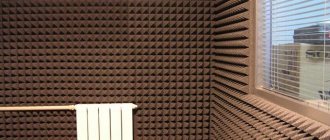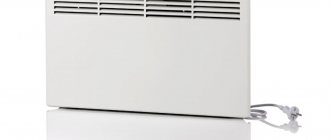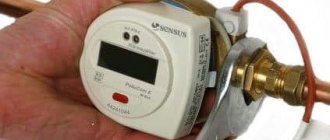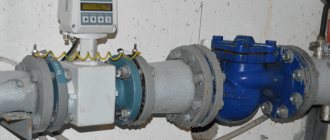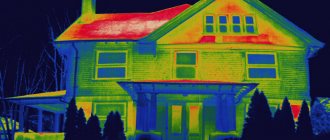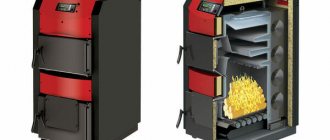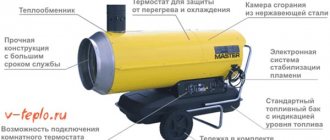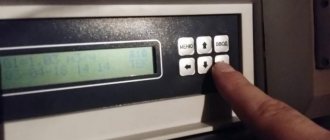Author of the article
Anton Bogdanov
Heat and gas supply and ventilation engineer. Prepares projects for gas supply to private houses.
Almost everyone has become accustomed to the fact that a meter for gas, electricity and water installed in an apartment helps save the budget. After all, thanks to metering devices, you can only pay for what you actually consume. But fewer people know that it is possible to install an apartment heat meter on heating pipes. The idea looks good, because in winter we pay serious sums for heating. Complete with the meter, you can install taps. They can regulate the level of heat entering the house so as not to swelter from the heat. You can practically turn off the heat supply if you are planning a long trip, and not have to pay for heating empty walls.
So what if you install a heating meter in your apartment? Will it help you save money? Let's try to answer all your questions in this article.
What the law says
The law in 2021 does not oblige the installation of individual heat energy meters in the apartment, but does not prohibit it either. In order to install a meter in an apartment, the meter must also be installed at the entrance to the building. According to Article 13, paragraph 5 of Federal Law No. 261-FZ of November 23, 2009, every apartment building must be equipped with a heat meter. So if the management company adheres to the law, then we can assume that the general building meter is installed by default.

Based on the law, Article 157 of the Housing Code of the Russian Federation, payment is made on the basis of a common building meter, and then the amount received is divided among all residents, taking into account the square footage of the apartment.
If the meter is also installed in the apartment, then the owner pays for the heat consumed by it and for general house consumption for heating the entrance, basement, or attic.
Classification and principle of operation of heat meters
The priority principle of operation of all similar products for metering thermal energy is readings at a certain water temperature.
Any heat accrual device consists of three components:
- Sensor;
- Unit for distribution, pressure and fluid resistance;
- Device for metering received thermal energy.
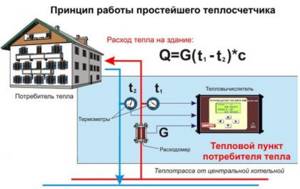
Scheme of the operating principle of a common house heat meter
In addition, meters are divided by purpose. They are available for individual and industrial (household) use.
Devices for houses with autonomous heating and apartments differ from house ones in more precise adjustment.
Heat energy metering devices for home use are divided into several types:
- Mechanical;
- Electromagnetic;
- Ultrasonic;
- Vortex devices.
To better understand their fundamental work, let’s look at each variety in more detail.
Tachometer instruments
The most affordable and understandable from the point of view of the average person are mechanical devices. Such devices use a rotating drum in the form of a small turbine as a meter.
Tachometer heat meter
It rotates from the pressure of the coolant, thanks to which water consumption is recorded. Typically, tachometer meters are equipped with two flow meters (on the inlet and outlet pipes), a resistance element and a heat calculator.
Sometimes devices are provided with pressure sensors. Such meters must have filters installed at the entrance. If the equipment is put into operation without them, then the presence of mechanical impurities (particles of sand, gravel, rust) will affect the operation of the device, and it will produce distorted readings.
Electromagnetic devices
This device's operating principle is based on the manifestation of electromagnetic induction. Inside the product there are several magnets that create a field of the same name.
Electromagnetic heat meter
As you know, water is a good conductor and when it passes through a magnetic field, an electric current is generated. Moreover, its value is directly proportional to the speed of fluid flow.
The generated electric current enters the computing node. And since the difference in current values is small, such devices require proper installation and special operating conditions.
Data readings will be distorted if the device is connected in violation of the required level (vertical instead of horizontal heating distribution in a high-rise building). And also at the junction there should not be a narrower throughput channel.
And one more factor that influences the reliability of information for coolants of this type is that the presence of iron in any form (scale, rust) is excluded in the water.
Ultrasonic heat metering
Meters with ultrasonic radiation are characterized by an unusual operating principle and high cost. The originality lies in measuring the passage of a wave through a liquid, depending on the speed of the coolant.
Ultrasonic heat meter
In other words, the flow rate is calculated by the time it takes for the signal to arrive from the radiation source to the receiver. In these products, strict placement of devices on the same line is important.
Vortex heat accounting
Turbulent-type devices are distinguished by a special measurement. In the path of the coolant in the pipeline there is a prism, which is an obstacle, and a vortex flow occurs.
Vortex heat meter
The number of vortex branches is recorded by special sensors and flow meters, which are located at a certain distance from the prism. And the stronger the flow speed, the greater the number of vortices formed.
approximate cost
The most affordable radiator meters are mechanical devices; they can be purchased for about 3,500 rubles.
Ultrasonic devices are more expensive; their prices start at 4,000 rubles.
On average, popular models cost around 5,000 – 6,000 thousand rubles.
When choosing a radiator meter, you need to know the diameter of the pipe on which the device will be installed. The thicker the pipe, the higher the cost of a heat meter suitable for it.
Typically the kit includes a calculator, a flow meter and a pair of sensors for the supply and return pipes. Additionally, you will have to purchase some parts:
- mechanical cleaning filter for the flow meter – 300 rubles;
- tee for connecting a temperature sensor – 800 rubles for 2 pieces;
- shut-off valve to shut off the flow of water - 500 rubles for 2 pieces;
- valve for regulating water flow - 1000 rubles for 2 pieces.
In almost any city there is a company that installs heat meters. Its representatives will help prepare the project, carry out installation and commission the device. Depending on the complexity and volume of work, the price for such services will range from 2,000 to 7,000 rubles.
In total, if you calculate the approximate cost of installing a meter, it comes out to 4,500 for the meter, 2,500 for additional parts and 4,000 rubles for the project and installation. It turns out 11,000 rubles.
If the house uses a vertical heating supply system, then a heat meter must be installed on each riser. In other words, you will have to install a thermal energy meter in each room, which will inevitably lead to an increase in the payback period.
For example, for a three-room apartment you will have to install a meter in all three rooms and in the kitchen, it turns out that instead of one device you will have to pay for four, and, accordingly, the payback of such a system will increase four times.

It is also worth considering that for corner apartments, where two walls in the room are external, radiators are installed on each wall, and accordingly in such a room there may be not one, but two risers, and you will have to install a meter on each heating radiator.
In connection with all these inconveniences caused by the vertical arrangement of pipes, heat distributors were invented. The cost of the device is 1000 rubles, installation 500 - 1000 rubles per piece. Thus, for a three-room room you will need 4 such distributors, this is 4000 rubles, 3000 for their installation and 500 rubles for shut-off valves or a valve for each battery, this is another 2000 rubles. This results in 10,000 rubles, which is comparable to installing one heat meter in a system with horizontal heat distribution.
Using smart meters to save energy
The greatest efficiency in energy saving is provided by devices that calculate the amount of energy consumed.
By using modern smart meters, losses of 10 to 30% can be prevented.
This is already proven savings achieved from their implementation in a number of regions of Russia.
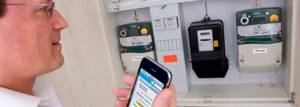
The main obstacle to the use of such accounting devices is the significant costs of purchase and installation.
However, significant capital costs still pay off within 8-9 years.
Currently, the country's government apparatus is working to legislate the procedure for accounting for electrical energy using new equipment.
Simultaneously with the adoption of the law, officials are going to adopt Rules that will allow the use of smart meters for energy saving.
For example, in one of the regions of Russia, a trial project for installing these devices was implemented, within the framework of which more than 20 thousand devices were installed.
An analysis of the achieved effect shows that thanks to this, electric energy losses among private consumers decreased by 37%.
On average, depending on the region and the number of residents, the use of metering devices can reduce electricity losses by 15-18%.
As a result, up to 158 million kWh will be saved.
This is the amount of energy that a large city consumes in 60-70 days.
In the pilot region, savings in financial terms amounted to about 11 million rubles per year.
The introduction of smart electricity metering devices allows increasing the profitability of network companies without increasing payment tariffs.

The use of smart meters will allow:
- effectively combat the theft of electrical energy;
- increase the useful supply of electricity to consumers;
- targeted influence on non-payers.
However, we cannot fail to mention the problems that may arise when using smart metering devices.
One of the main ones is the lack of a unified national standard for equipment and data exchange protocols.
Consequently, each network company can use its own devices, which complicates the construction of a common network and increases the cost of its deployment.
Additional problems hindering the implementation of intelligent accounting systems:
- lack of economic incentives for the introduction of energy saving technologies;
- high cost of creating and operating “smart” systems;
- lack of standards stipulating permissible energy losses along the way from supplier to consumer;
- lack of methods for calculating errors when using measuring instruments.
Another controversial point is the possibility of external influence.
Intelligent accounting systems are not immune to attacks by hackers who can interfere with their work, especially at the initial stage of implementation, when the system is most vulnerable.
Is it profitable to install IPU heat in an apartment?
Knowing the average price for installing a meter in an apartment is 11,000 rubles, you can estimate the approximate benefits. The price for installing distributors on batteries will be similar. According to calculations by heating engineers, savings on payments for consumed thermal energy average 30%.
For example, let’s take a three-room apartment with an area of 57 sq.m. The amount billed according to the standards for apartments with central heating is calculated based on the following parameters:
- Tariff for thermal energy. It is calculated in rubles per 1 Gcal. Set by government and varies by region;
- Consumption standard. Varies by region and varies by month;
- Square meters of living space.
For example, let’s take an apartment located in central Russia. The tariff for thermal energy in apartment buildings is about 1,900 rubles per 1 Gcal, and the consumption standard is 0.025 Gcal per sq.m. Thus, we get 1900 * 0.022 = 41.8 rubles. This is the price per 1 sq.m. multiply it by 57 squares and get an amount equal to 2382.6 rubles. This is how much you will need to pay per month for an apartment with a total area of 57 sq.m.
In colder months, this figure will be higher, since the boiler room will heat the coolant to a higher temperature, and the consumption standard will increase. And in warm months the coefficient will decrease. Thus, in the warmest months the coefficient is around 0.017 (1841.1 rubles per month), and in the coldest months, of which there are more, 0.026 (2815.8 rubles per month).
To calculate, let’s take an amount equal to 2,400 rubles per month. Payment for heat in the middle zone is charged from November to May, that is, 7 months. And for 7 months on average you will have to pay 17,000 rubles.
If we consider that the savings when using an individual heat meter for an apartment are 30%, then in 1 year the savings can reach 17,000 * 0.3 = 5,100 rubles.
Provided that the system is horizontal (only one device is needed for the entire apartment), 10,000 - 11,000 rubles were spent on installing the meter; in an apartment of 57 square meters, the meter will pay for itself in 2 years.
If the apartment has vertical wiring, then you will have to install several IPUs, and then the payback period increases significantly.

It is also worth considering that the service life of the meter is 10 - 12 years. And verification will need to be done once every 4-6 years, and you will also have to pay for it. But even if we take all this into account, over 12 years the heat meter will help save 61,200 rubles. From this amount you will have to subtract the cost of installing the meter (10,000 rubles), and you will also have to verify it 2 times during operation, this is about 2000 rubles per verification. As a result, it turns out that over 12 years, apartment heat meters will help save about 47,000 rubles.
pros
- real savings on heat bills;
- temperature adjustment;
- possibility of shutting off the heating if it is not required.
Minuses
- Large one-time cash costs;
- The benefits will only become apparent after a few years;
- The need for periodic inspections.
Why buy from #ALFAOPT?
A LARGE ASSORTMENT
We offer a wide range of heat meters for installation in apartments.
STORE and ENGINEERS
The company's competent engineers will provide free advice on any issue.
WHOLESALE, RETAIL
We make our clients the best price offer, which you will not find more profitable.
PAYMENT
A large selection of payment methods for the convenience of our customers.
INTERNATIONAL COMPANY
We have branches throughout Russia and Kazakhstan.
DELIVERY
A personal fleet of vehicles makes it possible to carry out prompt and safe delivery of orders.
STOCK
Regular promotions allowing you to purchase heat meters at an even better price.
GUARANTEE
Quality guarantee for each product presented in the catalog.
For wholesale purchases of metering devices, we offer significant discounts. regularly carries out deliveries in various volumes to any of the Russian regions.
Heat meter verification
As a rule, a new unit is sold with an initial verification of all sensors, confirming its functionality, performed at the manufacturer. Proof of its implementation can be a special sticker, stamp, or a corresponding entry indicated on the device itself and in the document attached to it. The next verification of the heat meter in Russia is carried out once every 4 years, 5 years or 6 years (the exact value varies depending on the installed device, indicated in its passport). According to Russian laws, verification is carried out at the expense of the owner of the metering unit or the property where it is installed.
How to find out if it is technically possible to install a personal heat meter
Before installing a heat meter for heating in an apartment, you need to take into account a number of factors that may complicate this process.
Is there a communal heat meter in an apartment building?
Initially, you need to make sure that the house has a collective metering device. According to current legislation, heat meters for heating in an apartment building must be installed without fail, otherwise you need to file a claim with the local management company.
However, there are situations (in very old houses) when it is technically impossible to install such a common house device. Then installing an IPU will also not work.
Vertical or horizontal layout
You also need to clarify what type of wiring is used in the house, and based on this, determine the advisability of installing a personal metering device. Most houses in Russia use a heating system made using vertical wiring. This means that each room in the apartment has its own riser to which the battery is connected.
Accordingly, there are many such risers in the house and it will be necessary to install apartment heat meters for each radiator. But this is unprofitable, so instead of meters, radiator heat distributors (calculators) are often installed on each of the batteries.
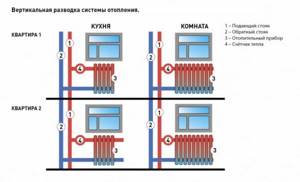
There are no problems with horizontal wiring; in such apartments there is one riser and all radiators are connected to it by horizontally laid pipes, so here you can install a heat meter on the supply pipe.
Apart from these restrictions, there are no longer any other obstacles to installing heat meters in an apartment. Is it possible that there is some special case associated with errors in the installation of the heating network.
Read how to calculate payments for heat meters.
Heat meter "Hephaestus"
Mechanical apartment (individual) heat meter "Gefest" - designed for commercial metering of thermal energy consumption in water systems, heat supply in the field of domestic heat consumption (apartments with horizontal wiring, small industrial premises and offices, cottages, etc.).
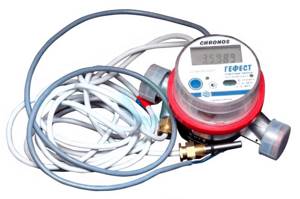
The main advantages of the Hephaestus heat meter
- Made in Russia;
- European quality standards;
- lifetime warranty;
- resistant to magnetic fields;
- verification interval - 6 years;
- heat metering in Gcal, display in Russian;
- compact dimensions;
- self-diagnosis function;
- ease of use - the display rotates 360°;
- convenient readings in any position;
- measurement of temperature difference - from 0.25 °C (suitable for studio apartments);
- measurement of thermal energy AND cooling energy;
- There is a modification with two pulse inputs.
To summarize all of the above, it is worth noting that any heat consumption monitoring device installed in an apartment must have a passport and a certificate confirming its compliance with operating requirements.
From ordering to receiving the heat meter there are only 4 steps
Application
Payment
Cargo assembly
Delivery
Which heat meter to choose for an apartment
There is a wide selection of heat meters for a variety of conditions. Here we also consider individual meters that are suitable in their capacity, size and design for use in an apartment.
Mechanical
Some of the simplest and, accordingly, cheapest meters are mechanical devices. Such counters are also called tachometers. Outwardly they resemble ordinary water meters, only with two wires, at the ends of which there are temperature sensors that determine the difference in temperature on the supply and return pipes. The meter itself consists of two parts: a mechanical water meter with blades, which cuts into the pipe, and an electronic computer unit.
pros
- Low cost
- Does not require connection to the electrical network;
- Easy installation on any type of pipe.
Minuses
- Verification every 4 years;
- They may fail due to water hammer.
For such a device, it is necessary to use a coarse filter.
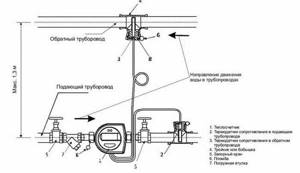
An example of inexpensive mechanical devices is the Hephaestus counter. The price of the cheapest device, suitable for installation in small apartments with a coolant flow rate of no more than 0.6 cubic meters per hour, does not exceed 4,000 rubles. There are also more productive models with a throughput capacity of up to 1.5 cubic meters per hour and a price of 4,500 rubles. There are also modifications with a pulse output and a radio channel for connection to an automatic data collection system.
Ultrasonic
The principle of operation is similar to the previous type of meter, but instead of mechanical blades, an emitter and a receiver are used here, which are placed from each other at a strictly specified distance, and the coolant flow is measured using an ultrasonic signal.
Pros:
- Affordable price;
- Durability.
Minuses:
- Complex installation carried out in accordance with relevant standards;
- High requirements for coolant purity;
- Verification every 4 years;
- Can only be installed on straight horizontal pipes.
An inexpensive representative of ultrasonic meters is the ECO NOM meter. For example, model ECO NOM STU-15.2 QN-1.5 M3/H. The number 15 means the diameter of the pipe; there are other modifications, for example, for a 20 pipe. 1.5 is the throughput; you can choose another suitable model, for example, with the number 0.6 or 2.5.
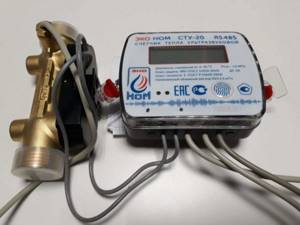
Calculator (Distributor)
Calculators and distributors are used in small apartments or in apartments with vertical distribution of the heating system. The difference between them is that the calculator has more capabilities, for example, it can show heat consumption in kW/hour on its screen.
The devices do not require insertion into the heating system; they are simply installed on each radiator and configured accordingly based on the type of battery. The device consists of two thermal sensors that measure the temperature of the battery and air in the room, and an adapter that performs calculations. In order not to combine all the readings from all batteries manually, for some models of calculators you can purchase a controller that wirelessly summarizes the readings of all calculators.
Pros:
- Low price;
- Possibility of installation on any type of pipe;
- Verification every 10 years;
- Easy installation.
Minuses:
- Distributor data is taken into account only if at least 50% of apartments in an apartment building are equipped with such distributors.
- The error is around 10%;
- The need to summarize data from all devices (on models without a summing controller);
- Correct operation only on factory models of heating devices.
- Calculating payments is quite complicated; residents cannot calculate the amount themselves; this is done by the heat supplier based on the provided data from all apartments.
Despite the ease of installation of the computer, its installation must be carried out by a professional who will correctly configure the device for specific conditions of use.
For example, the PULSE distributor “URT-100”. It costs 1,000 rubles and is designed to work with coolant temperatures from 35 to 105 degrees Celsius, which means it is suitable for measuring heat in the heating system of an apartment building.
The device is mounted between the radiator sections using fasteners. The case has an LCD display that displays information about current energy consumption. The meter also maintains a data archive. Remote data collection is possible.
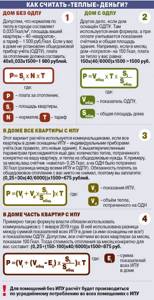
Electricity meters
There is a requirement for the population to use electric meters with an accuracy class of at least 2.0. Therefore, all old electricity meters with an accuracy class of 2.5 or less are currently being withdrawn from circulation. The rules for the functioning of retail electricity markets approved by the Government of the Russian Federation (Resolution No. 530 of August 31, 2006) establish requirements for the accuracy classes of electricity metering devices for different groups of consumers. See Rules for the supply of electrical energy.
Algorithm for legal installation of a heat meter
Before installing an individual heat meter, you need to follow the action algorithm step by step so as not to end up with a device that is not suitable for commissioning.
- Contacting the utility company. First of all, you need to contact the management company and discuss all the conditions for installing the meter. It happens that the management company resists installing an IPU for heat. But this is illegal, so this issue needs to be resolved immediately.
- Development of the project and its coordination with the management company. Next, you need to contact a certified company, which will draw up a project and estimate for the work. This company must have permission to install heat meters; a license to install a meter in an apartment is not required.
- Purchasing a device. Before purchasing a device, you need to know exactly which device is suitable for your existing heating system. Typically, all the necessary data for purchasing the correct device and consumables are given in the project with an estimate.
- Installation. Since installing a heat meter requires a connection to the centralized heating system, this work must be carried out by qualified workers. They will be able to connect the heat meter without disrupting the functioning of the system.
After installation is completed, you need to contact the representative office of the heat supply organization to install seals. And when the device is installed and sealed, you need to go back to the management company with all the documents.
Technical nuances and installation rules
Each central heating system requires its own meter and its own set of additional equipment. For systems with horizontal wiring, both mechanical and ultrasonic meters can be installed. Installation of a mechanical type meter is possible in almost any conditions; for the ultrasonic type there are a number of restrictions. Also, if there are a small number of batteries in the room and there is no desire to cut pipes, then you can install several computers. But there is a serious limitation here: calculating payments using such devices is only possible if more than half of the apartments in an apartment building are equipped with them.
But in an apartment with vertical wiring you will have to limit yourself to just using computers or distributors.
Due to the design features of such a system, installing a mechanical or ultrasonic meter is not profitable and is too cumbersome. Useful article? Rate and share with friends!
Mechanical (tachometer) heat meter
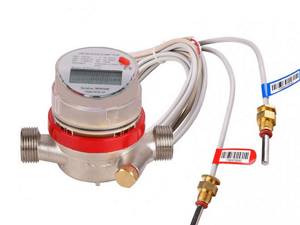
It has a rotary impeller and a recording mechanism that determines the number of rotations performed to calculate the volume of water passing through the pipes. The temperature of the coolant is recorded by an electronic module built into the body of the device. Data on the state of the water is supplied to it through two probes located at the inlet and outlet of the flow. The device is powered from an internal source. That is, this is a simple heat meter, in demand among private homeowners and apartment owners.
Pros: profitable and inexpensive device, quickly pays for itself, compact, small, with proper operation and regular maintenance, it has a long service life.
Cons: requires replaceable filters and constant monitoring, is sensitive to water quality and often clogs in the presence of foreign impurities (scale, scale, rust).



